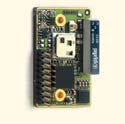E-Health and Connectivity 14758
April 1, 2003
Originally Published MPMN April 2003
SPECIAL
E-Health and Connectivity
How to Manage the Inevitable Push toward Device Networking
byZachary Turke
For many manufacturers, the question is not whether to network-enable their devices, but how to do so most cost-effectively. Recent developments in the healthcare industry have made the need for networked devices readily apparent. From the current nursing shortage to industry consolidation to the expanding use of outpatient treatment, health professionals are increasingly required to acquire more information in a shorter time with fewer staff. Network-enabled devices are the obvious solution to help them balance the scales.
But even if this transition wasn't quickly becoming a necessity, there are many reasons manufacturers should think about incorporating networking capabilities voluntarily. Networked devices facilitate a mobile workforce and enable information sharing between providers. They support paperless operations and accelerate billing and referral times. They also allow for the detailed analysis of pre-event situations and expand use in markets like home care. In the competitive medical marketplace, a device that can offer any of these value-added services to a customer has a competitive advantage over other products.
|
ConnectBlue Bluetooth Serial Port adapters from Code Blue Communications Inc. are examples of board-level solutions for network-enabling |
Different Solutions for Different Requirements
So if the push toward connectivity is both needed and desirable, how can you go about making your machine network most cost-effectively? To answer this question, you must first decide at which level you want to integrate networking functionality into the device. Chip, board-level, and external solutions are the three options currently available. Each solution has unique benefits that may make it the best choice for your device.
For devices that are already on the market and have an established user base, an external solution is probably best. This method generally involves the highest per-unit cost, but is also the quickest and easiest way to get a device to market. Plugging into an existing serial port, this product is a stand-alone unit that has a DB9 or DB25 connector on the serial side and a 10/100Base-T or a 10Base-FL connection on the Ethernet side. Also called a device server, it is a prepackaged hardware and software product that eliminates the need for a manufacturer to develop the components individually.
Board-level solutions are slightly more intrusive. Requiring motherboard space, an available serial port, and a power supply, these solutions generally have a lower per-unit cost than external products. They do, however, require a slightly greater level of development resources. Board-level components generally include a processor, a real-time operating system, a TCP/IP stack, a Web server, a network connection, and all of the other elements needed to successfully achieve device connectivity.
|
Network devices like this Catella workstation from American Medical Sales Inc. help physicians acquire more information in less time. |
When long development times are not an issue, chips are likely to be the most cost-effective option. These devices have the lowest per-unit cost but require the most time and resources to achieve connectivity. Also called Ethernet-controller integrated circuits, they are available with various levels of integration. Units on the simple end of the spectrum include just a media-access controller or physical-layer-interface electronics. More-advanced chips incorporate multiple interfaces, a processor, memory, and more. Some chips are supplied with a variety of software and tools to reduce product development times.
More:
Embedded Device Server Slashes Development Times
Where to Look for Help
Copyright ©2003 Medical Product Manufacturing News
You May Also Like



